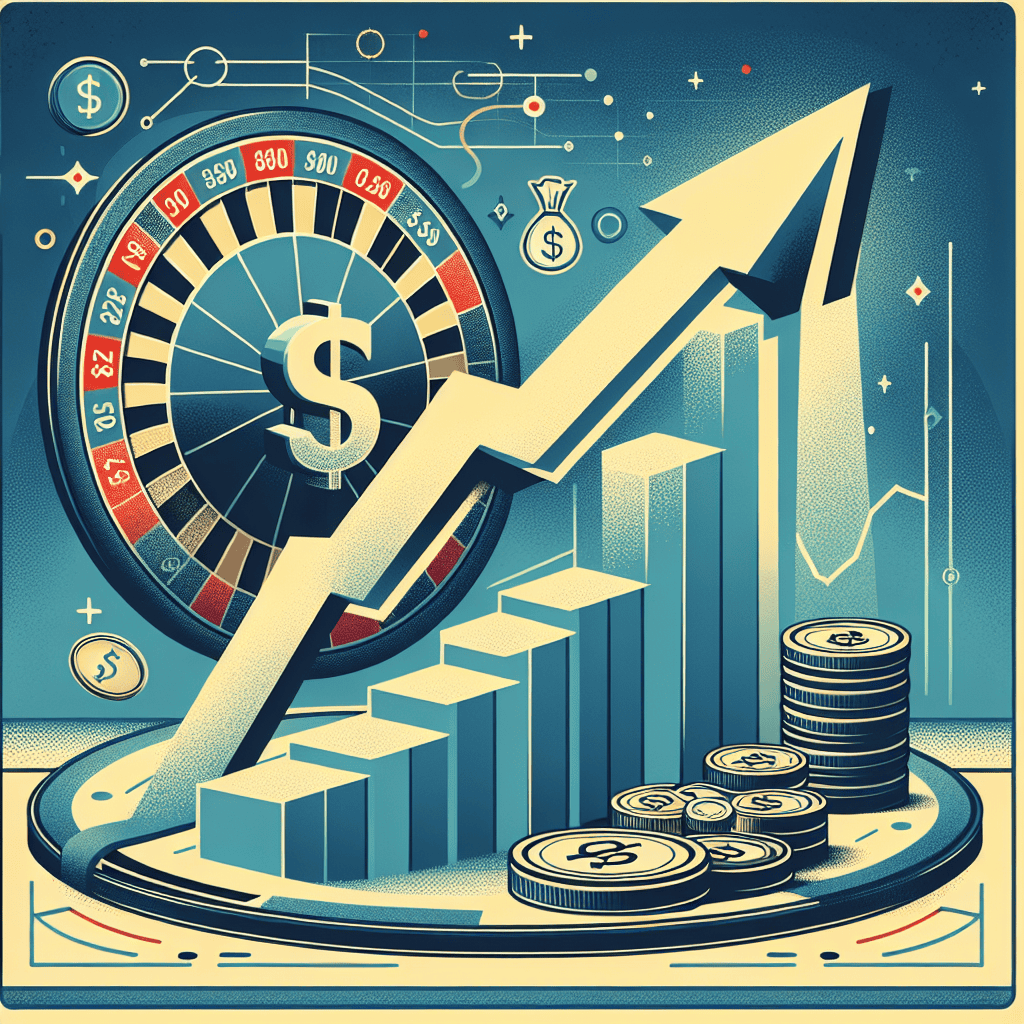“Standard Chartered: Navigating the Dollar’s Ascent Amid Trump-Driven Market Waves”
Introduction
Standard Chartered’s analysis, “Trump-Driven Bets Fuel Dollar’s Surge,” delves into the significant appreciation of the U.S. dollar, driven by market expectations and policy shifts during Donald Trump’s presidency. The report examines how Trump’s economic policies, including tax reforms, infrastructure spending, and regulatory changes, have influenced investor sentiment and global currency markets. It highlights the impact of these policies on capital flows and interest rate differentials, which have contributed to the dollar’s strength. Additionally, the analysis explores the broader implications for international trade, emerging markets, and global economic stability, providing insights into the complex interplay between U.S. domestic policy and global financial dynamics.
Impact Of Trump-Driven Policies On The Dollar’s Strength
The recent surge in the U.S. dollar’s value can be attributed to a confluence of factors, with policies driven by the Trump administration playing a pivotal role. Standard Chartered, a leading global bank, has highlighted how these Trump-driven bets have significantly impacted the dollar’s strength. To understand this phenomenon, it is essential to examine the policies and economic strategies that have contributed to the dollar’s appreciation.
One of the primary factors influencing the dollar’s rise is the administration’s focus on tax reforms. The Tax Cuts and Jobs Act, implemented during Trump’s tenure, aimed to stimulate economic growth by reducing corporate tax rates. This policy not only encouraged domestic investment but also attracted foreign capital, as investors sought to capitalize on the favorable tax environment. Consequently, the influx of foreign investment increased demand for the dollar, driving its value higher.
In addition to tax reforms, the administration’s trade policies have also played a crucial role in strengthening the dollar. The imposition of tariffs on imports from key trading partners was intended to protect domestic industries and reduce the trade deficit. While these measures sparked trade tensions, they also led to a reevaluation of global supply chains. As companies adjusted their strategies, the demand for the dollar increased, further bolstering its value.
Moreover, the Federal Reserve’s monetary policy during this period cannot be overlooked. Although the Fed operates independently, its decisions were influenced by the broader economic environment shaped by the administration’s policies. The anticipation of higher inflation and economic growth prompted the Fed to raise interest rates, making dollar-denominated assets more attractive to investors. This, in turn, contributed to the dollar’s appreciation.
Furthermore, geopolitical factors have also played a role in the dollar’s surge. The Trump administration’s approach to foreign policy, characterized by a focus on national interests and a departure from multilateral agreements, created an environment of uncertainty. In times of geopolitical tension, investors often seek safe-haven assets, and the U.S. dollar, being the world’s primary reserve currency, benefited from this trend. As a result, the demand for the dollar increased, reinforcing its strength.
It is also important to consider the impact of global economic conditions on the dollar’s performance. During Trump’s presidency, the U.S. economy demonstrated resilience compared to other major economies, which faced challenges such as slower growth and political instability. This relative strength of the U.S. economy made the dollar an attractive option for investors seeking stability and returns, further contributing to its appreciation.
While the Trump-driven policies have undeniably fueled the dollar’s surge, it is crucial to recognize that this strength is not without its challenges. A stronger dollar can have mixed effects on the U.S. economy, benefiting importers and consumers by making foreign goods cheaper, but potentially harming exporters by making American products more expensive abroad. Additionally, emerging markets with dollar-denominated debt may face increased repayment burdens, leading to financial instability.
In conclusion, the Trump administration’s policies have played a significant role in driving the U.S. dollar’s recent surge. Through tax reforms, trade policies, and the broader economic environment, these strategies have attracted investment and increased demand for the dollar. However, the implications of a stronger dollar are complex, with both positive and negative effects on the domestic and global economy. As such, it is essential for policymakers and investors to carefully consider these dynamics as they navigate the evolving economic landscape.
Standard Chartered’s Analysis Of The Dollar Surge
In recent months, the global financial landscape has been significantly influenced by the policies and rhetoric emanating from the Trump administration, leading to a notable surge in the value of the U.S. dollar. Standard Chartered, a prominent financial institution, has provided a comprehensive analysis of this phenomenon, attributing the dollar’s ascent to a series of Trump-driven bets that have reshaped investor expectations and market dynamics. As the administration’s economic agenda unfolds, it has become increasingly clear that the dollar’s strength is not merely a transient occurrence but rather a reflection of deeper structural shifts in the global economy.
To begin with, the anticipation of expansive fiscal policies under the Trump administration has played a pivotal role in bolstering the dollar. Investors have been particularly optimistic about the prospects of tax reforms and increased infrastructure spending, which are expected to stimulate economic growth and, consequently, drive up interest rates. This expectation of higher interest rates has made dollar-denominated assets more attractive, prompting a surge in demand for the currency. Moreover, the administration’s emphasis on deregulation has further fueled investor confidence, as it is perceived to create a more business-friendly environment that could enhance corporate profitability and economic expansion.
In addition to fiscal policy expectations, geopolitical factors have also contributed to the dollar’s rise. The Trump administration’s assertive stance on trade negotiations and its focus on renegotiating trade agreements have introduced a degree of uncertainty in global markets. This uncertainty has led investors to seek safe-haven assets, with the dollar emerging as a preferred choice due to its status as the world’s primary reserve currency. Consequently, geopolitical tensions have inadvertently strengthened the dollar, as market participants hedge against potential disruptions in international trade.
Furthermore, Standard Chartered’s analysis highlights the role of monetary policy divergence in the dollar’s appreciation. While the Federal Reserve has signaled a gradual tightening of monetary policy, other major central banks, such as the European Central Bank and the Bank of Japan, have maintained more accommodative stances. This divergence has widened interest rate differentials, making U.S. assets more appealing to investors seeking higher returns. As a result, capital flows into the United States have increased, exerting upward pressure on the dollar.
However, it is important to note that the dollar’s surge is not without its challenges. A stronger dollar can have adverse effects on U.S. exports by making them more expensive for foreign buyers, potentially widening the trade deficit. Additionally, emerging markets with significant dollar-denominated debt may face increased repayment burdens, leading to financial instability in those regions. These potential repercussions underscore the complexity of the current economic environment and the need for careful navigation by policymakers and market participants alike.
In conclusion, Standard Chartered’s analysis provides valuable insights into the factors driving the dollar’s recent surge, emphasizing the interplay between fiscal policy expectations, geopolitical dynamics, and monetary policy divergence. As the Trump administration continues to implement its economic agenda, the implications for the dollar and the broader global economy will remain a focal point for investors and analysts. While the dollar’s strength reflects a confluence of factors, it also presents challenges that require vigilant monitoring and strategic responses to ensure sustainable economic growth and stability.
Global Market Reactions To The Dollar’s Rise
The recent surge in the U.S. dollar has captured the attention of global markets, with Standard Chartered attributing this phenomenon to Trump-driven bets. As investors react to the evolving economic landscape, the dollar’s appreciation has sparked a series of reactions across various financial sectors worldwide. Understanding the implications of this rise requires a closer examination of the underlying factors and the subsequent market responses.
The dollar’s ascent can be largely attributed to the economic policies and rhetoric associated with former President Donald Trump. His administration’s focus on tax cuts, deregulation, and infrastructure spending created an environment conducive to economic growth, thereby attracting investors seeking higher returns. As a result, the dollar strengthened against other major currencies, reflecting increased confidence in the U.S. economy. This appreciation was further bolstered by the Federal Reserve’s monetary policy stance, which included gradual interest rate hikes aimed at curbing inflation and maintaining economic stability.
As the dollar gained momentum, global markets began to adjust to the new economic reality. Emerging markets, in particular, felt the impact of the stronger dollar, as many of these economies rely heavily on dollar-denominated debt. A rising dollar increases the cost of servicing this debt, putting pressure on their financial systems and potentially leading to capital outflows. Consequently, countries with significant exposure to U.S. currency fluctuations have had to implement measures to stabilize their economies, such as tightening monetary policy or seeking alternative funding sources.
In addition to emerging markets, the dollar’s rise has also affected commodity prices. Since many commodities are priced in dollars, a stronger dollar makes them more expensive for buyers using other currencies. This dynamic has led to fluctuations in the prices of key commodities such as oil, gold, and agricultural products. For instance, oil-importing countries have faced higher costs, impacting their trade balances and inflation rates. Conversely, oil-exporting nations have benefited from increased revenues, although the overall effect on their economies depends on various factors, including production levels and domestic economic conditions.
Moreover, the dollar’s appreciation has influenced global trade dynamics. A stronger dollar makes U.S. exports more expensive and less competitive in international markets, potentially leading to a trade imbalance. This situation has prompted some countries to reassess their trade strategies, seeking to diversify their export markets or renegotiate trade agreements to mitigate the impact of the dollar’s strength. At the same time, U.S. consumers have experienced increased purchasing power for imported goods, which could affect domestic industries facing competition from foreign products.
As global markets continue to navigate the complexities of a rising dollar, investors and policymakers alike are closely monitoring the situation. The interplay between U.S. economic policies, Federal Reserve actions, and global market reactions will likely shape the trajectory of the dollar in the coming months. While the Trump-driven bets have fueled the dollar’s surge, the long-term implications remain uncertain, as geopolitical developments, trade negotiations, and economic indicators continue to evolve.
In conclusion, the dollar’s recent rise, driven by Trump-era economic policies and investor sentiment, has had far-reaching effects on global markets. From emerging economies grappling with increased debt costs to shifts in commodity prices and trade dynamics, the implications are multifaceted and complex. As stakeholders assess the impact of these changes, the global financial landscape will undoubtedly continue to adapt to the challenges and opportunities presented by the dollar’s strength.
Investment Strategies Amidst A Strong Dollar

In recent months, the financial markets have witnessed a significant surge in the value of the U.S. dollar, a development largely driven by strategic bets influenced by the policies and rhetoric of former President Donald Trump. This phenomenon has captured the attention of investors and financial analysts worldwide, prompting a reevaluation of investment strategies amidst a robust dollar environment. As the dollar strengthens, it is crucial to understand the underlying factors contributing to this trend and the potential implications for global investment portfolios.
The dollar’s recent ascent can be attributed to a confluence of factors, with Trump’s economic policies playing a pivotal role. During his tenure, Trump’s administration implemented a series of tax cuts and deregulation measures aimed at stimulating domestic economic growth. These policies, coupled with a focus on repatriating overseas profits, have bolstered investor confidence in the U.S. economy, thereby increasing demand for the dollar. Furthermore, Trump’s trade policies, characterized by tariffs and renegotiated trade agreements, have also contributed to the dollar’s appreciation by creating a perception of a more competitive U.S. market.
As the dollar continues to gain strength, investors are faced with the challenge of adapting their strategies to navigate this evolving landscape. A strong dollar typically exerts downward pressure on commodities priced in dollars, such as oil and gold, making them more expensive for foreign buyers. Consequently, investors with significant exposure to these commodities may need to reassess their positions to mitigate potential losses. Additionally, multinational corporations with substantial overseas revenues may experience reduced earnings when these revenues are converted back into a stronger dollar, prompting investors to scrutinize their equity holdings in such companies.
In light of these dynamics, diversification emerges as a key strategy for investors seeking to hedge against the risks associated with a strong dollar. By allocating assets across various currencies and regions, investors can reduce their exposure to currency fluctuations and enhance the resilience of their portfolios. Moreover, investing in sectors that benefit from a strong dollar, such as domestic-focused industries and importers, can provide a buffer against potential adverse effects.
Another consideration for investors is the impact of a strong dollar on emerging markets. Historically, a robust dollar has posed challenges for emerging economies, as it increases the cost of servicing dollar-denominated debt and can lead to capital outflows. Consequently, investors with exposure to emerging markets may need to exercise caution and conduct thorough due diligence to identify opportunities that can withstand the pressures of a strong dollar environment.
In conclusion, the recent surge in the U.S. dollar, driven in part by Trump-era policies, presents both challenges and opportunities for investors. By understanding the factors contributing to the dollar’s strength and adjusting their investment strategies accordingly, investors can navigate this complex landscape with greater confidence. Emphasizing diversification, focusing on sectors that benefit from a strong dollar, and carefully evaluating emerging market exposures are essential steps in crafting a resilient investment strategy amidst a strong dollar. As the global economic environment continues to evolve, staying informed and adaptable will be crucial for investors seeking to optimize their portfolios in the face of currency fluctuations.
The Role Of Standard Chartered In Currency Markets
Standard Chartered has long been a significant player in the global currency markets, leveraging its extensive network and expertise to influence currency trends and provide strategic insights. Recently, the bank’s role has become even more pronounced as it navigates the complexities of a rapidly evolving economic landscape. One of the most notable developments in this context is the surge of the U.S. dollar, driven in part by market bets related to policies and economic strategies associated with former President Donald Trump. This phenomenon has underscored the intricate interplay between political developments and currency valuations, with Standard Chartered at the forefront of analyzing and responding to these shifts.
The bank’s strategic positioning allows it to offer a unique perspective on the factors driving the dollar’s strength. As investors and market participants react to policy changes and geopolitical events, Standard Chartered’s insights become invaluable. The bank’s analysts have noted that the anticipation of tax reforms, deregulation, and infrastructure spending under the Trump administration initially fueled optimism about U.S. economic growth. This optimism, in turn, led to increased demand for the dollar as investors sought to capitalize on potential economic expansion and higher interest rates.
Moreover, Standard Chartered’s role extends beyond mere analysis; it actively engages in currency trading, providing liquidity and facilitating transactions that reflect these market sentiments. The bank’s ability to execute large-scale trades efficiently makes it a crucial player in the currency markets, influencing supply and demand dynamics. As a result, Standard Chartered not only interprets market trends but also contributes to shaping them through its trading activities.
In addition to its trading prowess, Standard Chartered’s research division plays a pivotal role in guiding clients through the complexities of currency markets. The bank’s economists and strategists offer detailed reports and forecasts, helping clients understand the potential impacts of political developments on currency valuations. This guidance is particularly valuable in times of uncertainty, as it enables clients to make informed decisions and manage risks effectively.
Furthermore, Standard Chartered’s global presence allows it to provide a comprehensive view of currency markets, taking into account regional variations and cross-border influences. The bank’s extensive network in Asia, Africa, and the Middle East positions it uniquely to assess how developments in these regions interact with global trends. This holistic approach ensures that Standard Chartered’s clients receive well-rounded insights that consider both local and international factors.
As the dollar continues to experience fluctuations driven by various economic and political factors, Standard Chartered remains a key player in navigating these changes. The bank’s ability to adapt to shifting market conditions and provide strategic guidance underscores its importance in the currency markets. By leveraging its expertise and global reach, Standard Chartered not only helps clients navigate the complexities of currency trading but also contributes to the broader understanding of how political developments, such as those associated with the Trump administration, can influence currency valuations.
In conclusion, Standard Chartered’s role in the currency markets is multifaceted, encompassing analysis, trading, and strategic guidance. The bank’s insights into the Trump-driven bets that have fueled the dollar’s surge highlight its capacity to interpret and influence market trends. As global economic dynamics continue to evolve, Standard Chartered’s expertise will remain crucial in helping market participants navigate the intricate world of currency trading.
Economic Implications Of A Strengthened Dollar
The recent surge in the U.S. dollar, driven by market bets on policies associated with former President Donald Trump, has significant economic implications both domestically and globally. As the dollar strengthens, it exerts a profound influence on various economic sectors, affecting trade balances, corporate earnings, and emerging markets. Understanding these implications is crucial for policymakers, businesses, and investors navigating the complexities of a globalized economy.
To begin with, a stronger dollar makes U.S. exports more expensive for foreign buyers, potentially leading to a decrease in demand for American goods abroad. This shift can widen the trade deficit, as imports become relatively cheaper for U.S. consumers. Consequently, American manufacturers may face increased competition from foreign producers, which could impact domestic production and employment levels. Moreover, industries heavily reliant on exports, such as agriculture and manufacturing, may experience reduced profitability, prompting calls for policy interventions to mitigate adverse effects.
In addition to trade dynamics, the appreciation of the dollar has significant ramifications for multinational corporations. Companies with substantial overseas operations may see their foreign earnings diminish when converted back into dollars, affecting their bottom lines. This currency translation risk can lead to volatility in corporate earnings reports, influencing stock prices and investor sentiment. Furthermore, firms with dollar-denominated debt in foreign countries may encounter increased repayment costs, straining their financial positions and potentially leading to credit downgrades.
Transitioning to the global stage, emerging markets are particularly vulnerable to a strengthened dollar. Many of these economies rely on dollar-denominated debt to finance growth and development projects. As the dollar appreciates, the cost of servicing this debt rises, placing additional pressure on government budgets and corporate balance sheets. This scenario can lead to capital outflows, currency depreciation, and heightened inflationary pressures in these regions, exacerbating economic instability. Consequently, emerging market policymakers may be compelled to implement measures such as interest rate hikes or capital controls to stabilize their economies, which could further dampen growth prospects.
Moreover, the dollar’s surge influences global commodity markets, as many commodities are priced in dollars. A stronger dollar typically leads to lower commodity prices, impacting countries that rely heavily on commodity exports for revenue. For instance, oil-exporting nations may experience reduced income, affecting their fiscal budgets and economic growth. On the other hand, countries that import commodities may benefit from lower prices, potentially easing inflationary pressures and supporting consumer spending.
In light of these multifaceted implications, it is essential for policymakers to carefully consider the broader economic context when formulating responses to a strengthened dollar. Coordinated international efforts may be necessary to address potential imbalances and ensure global economic stability. Additionally, businesses must adopt strategic measures to hedge against currency risks and protect their financial health in an increasingly volatile environment.
In conclusion, the surge in the U.S. dollar, fueled by Trump-driven market bets, presents a complex array of economic challenges and opportunities. While it may benefit certain sectors and consumers domestically, it poses significant risks to trade balances, corporate earnings, and emerging markets. As the global economy continues to evolve, understanding and addressing the implications of a strengthened dollar will be crucial for sustaining economic growth and stability.
Future Predictions For The Dollar’s Trajectory
The recent surge in the U.S. dollar, driven by a series of Trump-era economic policies, has captured the attention of global financial markets. As investors navigate this complex landscape, Standard Chartered has provided insights into the future trajectory of the dollar, offering a nuanced perspective on what lies ahead. The bank’s analysis suggests that the dollar’s recent strength is not merely a short-term phenomenon but rather a reflection of deeper structural shifts in the global economy.
To begin with, the policies implemented during the Trump administration, particularly tax cuts and deregulation, have had a lasting impact on the U.S. economy. These measures have bolstered corporate profits and spurred economic growth, thereby increasing the attractiveness of U.S. assets. Consequently, foreign investors have flocked to the dollar, driving up its value. This influx of capital has been further amplified by the Federal Reserve’s monetary policy stance, which, despite recent rate hikes, remains relatively accommodative compared to other major central banks.
Moreover, geopolitical tensions and uncertainties have also played a significant role in the dollar’s ascent. In times of global instability, the dollar is often perceived as a safe haven, prompting investors to seek refuge in U.S. assets. This trend has been particularly evident in recent months, as trade disputes and geopolitical conflicts have intensified. As a result, the demand for the dollar has surged, reinforcing its upward trajectory.
Looking ahead, Standard Chartered’s analysis indicates that the dollar’s strength is likely to persist, albeit with some fluctuations. One key factor supporting this outlook is the relative resilience of the U.S. economy. Despite challenges such as inflationary pressures and supply chain disruptions, the U.S. economy has demonstrated a remarkable ability to adapt and recover. This resilience is expected to continue, providing a solid foundation for the dollar’s sustained strength.
Furthermore, the divergence in monetary policy between the Federal Reserve and other central banks is likely to widen, further supporting the dollar. While the Fed has signaled its intention to gradually tighten monetary policy, other central banks, particularly in Europe and Japan, are expected to maintain a more accommodative stance. This divergence is likely to attract more capital flows into the U.S., thereby bolstering the dollar.
However, it is important to note that the dollar’s trajectory is not without risks. Potential headwinds include the possibility of a slowdown in the U.S. economy, driven by factors such as rising interest rates and fiscal constraints. Additionally, any resolution of geopolitical tensions could reduce the demand for safe-haven assets, potentially dampening the dollar’s appeal.
In conclusion, while the dollar’s recent surge has been fueled by Trump-driven bets and geopolitical uncertainties, its future trajectory will be shaped by a complex interplay of economic, monetary, and geopolitical factors. Standard Chartered’s analysis suggests that the dollar is likely to remain strong in the near term, supported by the resilience of the U.S. economy and divergent monetary policies. However, investors should remain vigilant, as potential risks could alter the dollar’s path. As the global economic landscape continues to evolve, the dollar’s journey will undoubtedly be one to watch closely.
Q&A
1. **What is the main focus of the article?**
The article discusses how bets driven by policies and expectations from the Trump administration have contributed to the surge of the U.S. dollar.
2. **How has Standard Chartered been involved in the dollar’s surge?**
Standard Chartered, like many financial institutions, has been analyzing and possibly participating in market activities influenced by the dollar’s strength due to Trump-driven economic policies.
3. **What specific Trump policies are influencing the dollar’s rise?**
Policies such as tax reforms, infrastructure spending, and deregulation are expected to boost economic growth, thereby strengthening the dollar.
4. **What are the potential risks mentioned in the article related to the dollar’s surge?**
Potential risks include market volatility, trade imbalances, and the impact on emerging markets that may struggle with dollar-denominated debt.
5. **How has the market reacted to the Trump administration’s economic policies?**
The market has generally reacted positively, with increased investor confidence leading to a stronger dollar and higher stock market indices.
6. **What impact does a stronger dollar have on global trade?**
A stronger dollar can make U.S. exports more expensive and imports cheaper, potentially widening the trade deficit and affecting global trade dynamics.
7. **What is Standard Chartered’s outlook on the future of the dollar?**
While the article may not provide a specific forecast, Standard Chartered likely continues to monitor economic indicators and policy developments to assess the dollar’s future trajectory.
Conclusion
The article “Standard Chartered: Trump-Driven Bets Fuel Dollar’s Surge” likely discusses how the policies and economic strategies associated with former President Donald Trump have influenced market behavior, leading to a significant appreciation of the U.S. dollar. Factors such as tax reforms, deregulation, and fiscal stimulus under Trump’s administration may have increased investor confidence and demand for dollar-denominated assets, thereby strengthening the currency. Additionally, geopolitical dynamics and trade policies could have further contributed to this trend. In conclusion, the Trump administration’s economic policies and market perceptions have played a crucial role in driving the dollar’s surge, as analyzed by Standard Chartered.





